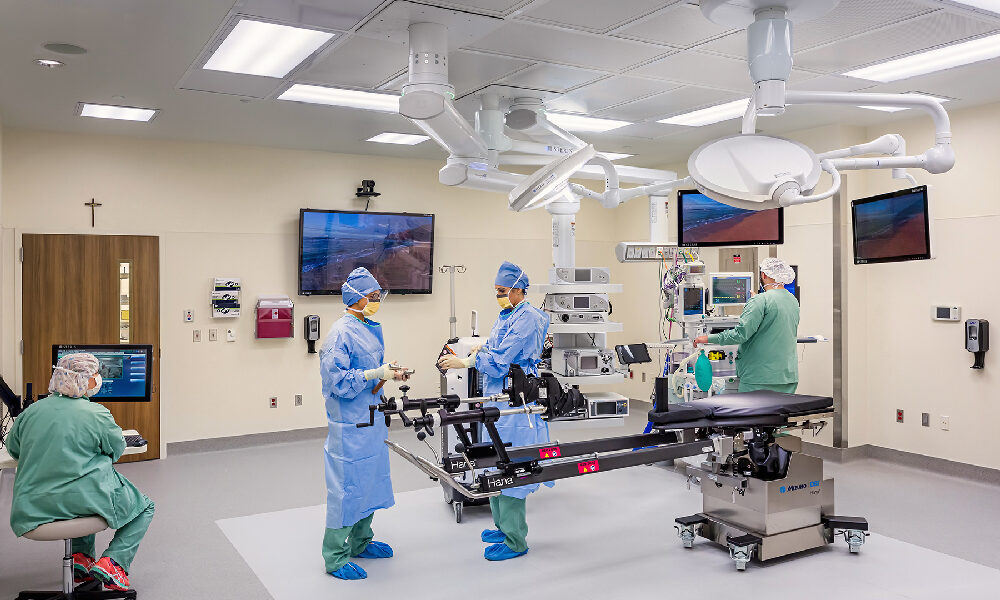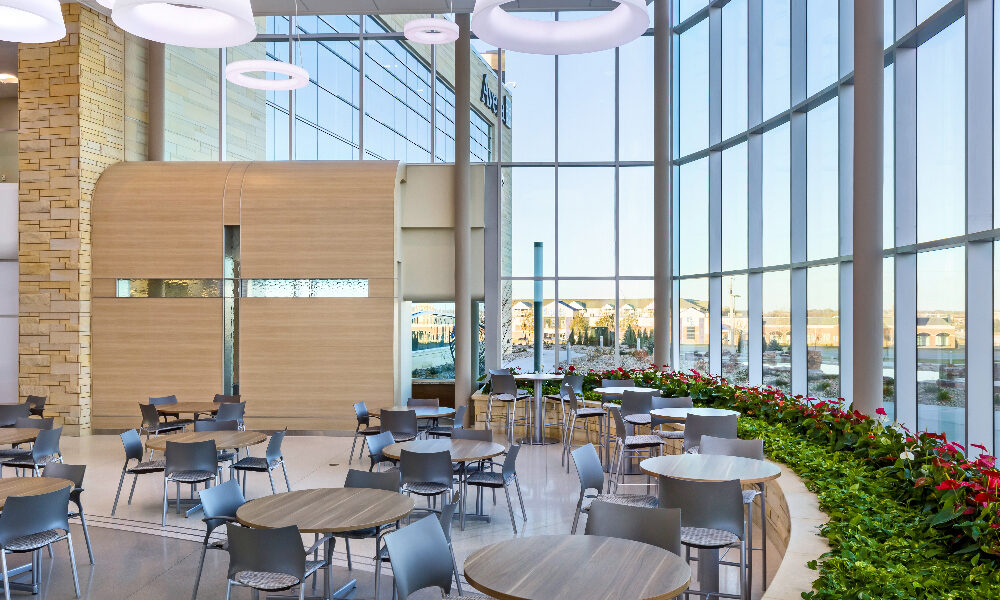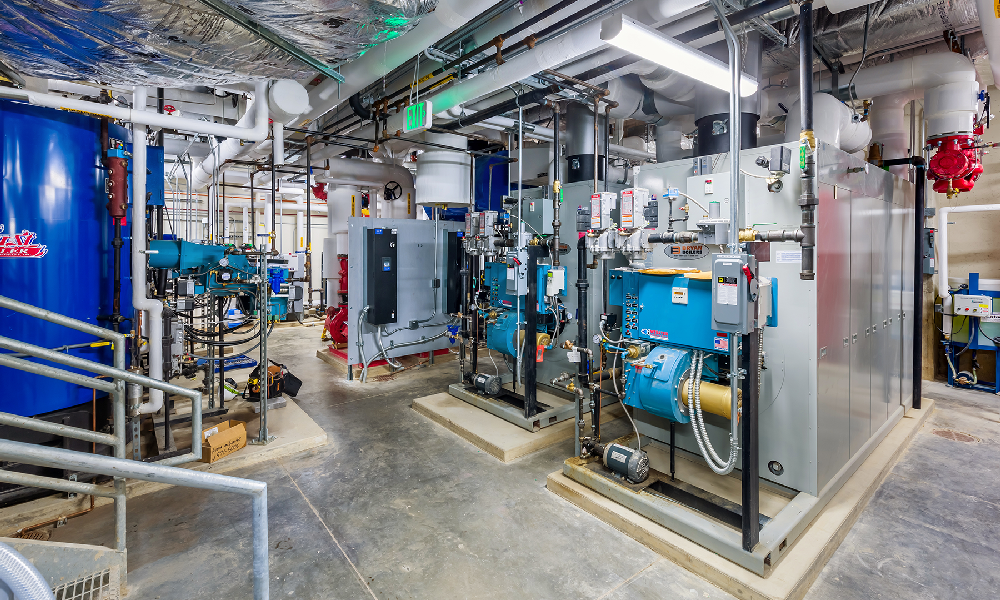 Unlike commercial buildings where air is constant at a recommended 72 F, hospital air can vary from 68 F in a normal operating room, to over 90 F in a burn unit.
Unlike commercial buildings where air is constant at a recommended 72 F, hospital air can vary from 68 F in a normal operating room, to over 90 F in a burn unit.  Sensors for factors such as occupancy and light can be linked to a building management system that complement facilities teams in the overall operations of the space.
Sensors for factors such as occupancy and light can be linked to a building management system that complement facilities teams in the overall operations of the space.  Walking paths, water features, art and a greenroof were a few strategies implemented in the design of Avera on Louise Health Campus in Sioux Falls, South Dakota.
Walking paths, water features, art and a greenroof were a few strategies implemented in the design of Avera on Louise Health Campus in Sioux Falls, South Dakota.  A heat recovery chiller system supplements the water boilers to improve overall efficiency and provide year-round heating. The system also includes a 1,000 ton chilled water plant with variable primary pumping.
A heat recovery chiller system supplements the water boilers to improve overall efficiency and provide year-round heating. The system also includes a 1,000 ton chilled water plant with variable primary pumping. Subscribe Now
Operational Wellness: Sustainable MEP Strategies that Complement Care Environments
By Alex Metschke
With the 2030 Challenge pushing engineers and architects toward designs that are net-neutral for energy consumption, the challenge for those in the healthcare sector is how to achieve decarbonization and sustainability goals among competing demands and code requirements.
In 2019, Avera Health opened its Avera on Louise Health Campus with a vision to use its size and location as a tool to promote wellness alongside the treatment of illness. Walking paths, water features, art and a greenroof were a few strategies the Sioux Falls, South Dakota-based healthcare organization implemented to achieve the goal.
The mechanical, electrical and plumbing system specified for the project was also designed to complement the efforts. A hybrid boiler system with three 60 horsepower firetube high-pressure steam boilers, and two 5,000 MBH heating water boilers power domestic water heaters, humidification, sterilization equipment and space heating needs in the 260,000-square-foot facility housing a 24-bed surgical specialty hospital, and multistory medical office building.
A heat recovery chiller system supplements the water boilers to improve overall efficiency, providing year-round heating. Additionally, the system includes a 1,000 ton chilled-water plant with variable-primary pumping.
The energy plant was configured to be modular and expandable, utilizing total energy-recovery concepts where a combination of high-efficiency boilers and heat recovery chillers serve the facility in an effort to reduce natural gas usage, while having the availability when needed during peak operating conditions. The system configuration provides added equipment redundancies to make pro-active heating decisions based on real-time utility costs.
While several steps from an idea of decarbonizing a healthcare facility, the effort showcases what can be achieved when sustainability and energy efficiency are integrated into the design of a healthcare center.
A cost to clean air
In the midst of the COVID pandemic, several strategies sought for hospitals was to isolate units, increase in-room filtration and implement outside air intake to avoid recirculating indoor air that could exacerbate the situation. However, the more outside air brought in, the more energy used as it must be heated, or cooled, since outside air can enter at low temperatures – think freezing levels – or at high temperatures above 90 F.
Heating and cooling outside air to render it appropriate for a treatment space is costly. Unlike commercial buildings, where air is constant at a recommended 72 F, depending on the use of the space, hospital air can vary from 68 F (some ORs prefer lower to around 65 F) in a normal operating room – to over 90 F in a burn unit. Maternity wards and clinical spaces are typically regulated at 75 F.
Moving past creation of Btu
Beyond regulating temperatures in each care setting, hospitals also spend inordinate energy lighting spaces to recommended levels, as well as heating water for everything from sterilization to cooking.
Traditionally, the approach has been to focus on the creation or use of Btu. As more focus is placed on lower emissions and sustainability, the shift should be away from creation to the movement of Btu from one side to the other, versus discarding.
Simply stated, there needs to be greater effort on recovering energy, not just spending it. As in the Avera on Louise example, systems have the capacity to recover heat to supplement other systems, such as water boilers. Such systems have the capacity to improve efficiency.
In addition, geothermal technologies are progressing to be both accessible and cost-effective for commercial use. Because the ground temperature remains more constant than air temperature, geothermal provides a source of reliable heating that can be harnessed for both heating and cooling applications, and can improve equipment efficiencies relative to their counterparts that reject or inject heat into the atmosphere. If the ground heat is higher than the ambient air temperature, geothermal systems can be used to move that heat from the ground to the building. Similarly, heat can be moved from the air to the ground, cooling a building.
A collaborative approach
This is not to say the system is free of fossil fuels, as electricity is used to operate the pumps. However, a hospital in Edgerton, Wisconsin protected itself from the market fluctuations of natural gas by reducing its reliance on it. As local utilities begin to expand their renewable energy generation and other carbon neutral sources within their portfolio, the higher electrical-site usage will reduce the overall carbon footprint, as a higher percentage of electricity used will be from a source relying less on greenhouse gas-generating fuel.
Solar and photovoltaic offer solutions for healthcare facilities to be paired with other systems, both offsetting costs and providing an effective solution to sustainability, especially as capital costs have decreased to make the systems more accessible. Such a solution requires both the right building orientation, and the right electrical infrastructure to support and operate the system.
When the engineering team is engaged in the design of a facility is almost as important as what knowledge the engineers bring to the project. An integrated design process allows the engineering team to engage early with the project, work with the organization’s leaders to understand their goals and help them apply realistic definitions to achieving those goals.
Data, data, data
The largest opportunity for improvement is in the existing programming. With the focus on critical operations, sequencing is often overlooked. However, the right devices installed at design can unearth data that helps improve facility operations. It’s much more expensive to identify these gaps during the building’s occupancy phase and install after the fact.
Calibrating systems to the actual demand in a space can have significant impacts on energy intensity-use levels. For example, out of the many ORs in a hospital, not every one of them is being used all the time. By sequencing the use of the space, mechanical systems can be programmed to actual use. This will cut down on ventilation by 75% if good strategies and an effective control sequence for each individual space can be implemented.
Sensors for factors such as occupancy and light can be linked to a building management system that complement facilities teams in the overall operations of the space. Such systems can monitor whether a door is opened or closed, which is important for rooms that have pressure compartments. Monitoring occupancy can also regulate how much ventilation is required in the room at a particular time.
As with all forms of data, it is only as good as what is being collected. When used effectively, the data collected through BMS can both help with energy conservation, as well as assist staff in learning what assumptions about operating conditions are correct and incorrect.
Understanding needs and pragmatism are important to reaching a hospital’s energy-efficiency goals. Growing studies show that upfront investments garner a faster payback in savings than what was once thought achievable. In the case of the hospital in Wisconsin, a 15-year payback plan for sustainable energy options occurred in six years.
Much thought goes into the design of a building. By giving the same amount of attention to a facility’s maintenance and operations, organizations can reduce reliance on fossil fuels like natural gas, improve the building’s sustainability and become a significant contributor in the reduction of carbon emissions to positively impact the health of everyone.
Photos courtesy of Specialized Engineering Solutions.
Author: Alex Metschke
Alex Metschke, MBA, PE, CEM, CCP, is director of energy and sustainability for Specialized Engineering Solutions, Omaha, Nebraska. He can be reached at ametschke@specializedeng.com.
Tags: Engineering, Sustainability
Posted July 12, 2022
More Articles:
- CxA Workshop & Exam
Apr 29, 2024 – Apr 30, 2024 - EMP Seminar & Exam at CxEnergy 2024
Apr 29, 2024 – Apr 30, 2024 - CxEnergy
Apr 29, 2024 – May 2, 2024 - PHCC West 2024
Apr 29, 2024 – May 2, 2024 - Lean in Design Forum 2024
May 1, 2024 – May 2, 2024 - IFMA’s Facility Fusion Conference & Expo
May 5, 2024 – May 7, 2024 - ASHE Academy 2024
May 6, 2024 – May 10, 2024










